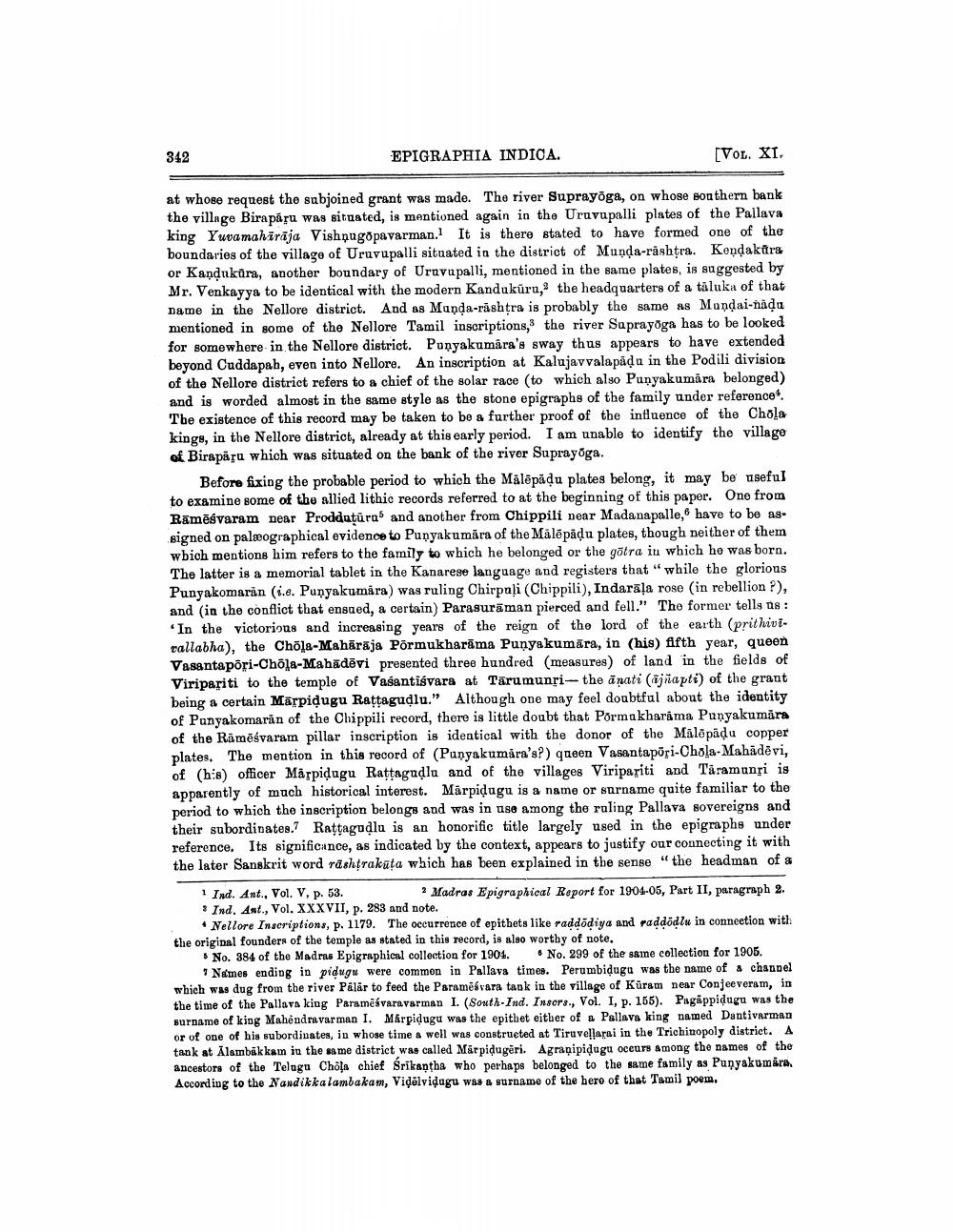________________
342
EPIGRAPHIA INDICA.
[VOL. XI.
at whose request the subjoined grant was made. The river Suprayoga, on whose southern bank the village Birapāļu was situated, is mentioned again in the Uruvupalli plates of the Pallava king Yuvamahīrāja Vishnugopavarman. It is there stated to have formed one of the boundaries of the village of Uruvupalli situated in the district of Munda-rashtra. Kendakūra or Kandukura, another boundary of Uruvupalli, mentioned in the same plates, is suggested by Mr. Venkayya to be identical with the modern Kandukuru, the headquarters of a taluka of that Dame in the Nellore district. And as Manda-rashtra is probably the same as Mandai-nadu mentioned in some of the Nellore Tamil inscriptions, the river Saprayoga has to be looked for somewhere in the Nellore district. Punyakumāra's sway thus appears to have extended beyond Cuddapah, even into Nellore. An inscription at Kalujavvalapādu in the Podili division of the Nellore district refers to a chief of the solar race to which also Punyakumara belonged) and is worded almost in the same style as the stone epigraphs of the family under reference 'The existence of this record may be taken to be a further proof of the influence of the Chola kinge, in the Nellore district, already at this early period. I am unable to identify the village of Birapasu which was situated on the bank of the river Suprayoga.
Before fixing the probable period to which the Mälēpådu plates belong, it may be useful to examine some of the allied lithic records referred to at the beginning of this paper. One from Rāmēšvaram near Prodduţüras and another from Chippili near Madanapalle, have to be assigned on palæographical evidence to Punyakumāra of the Malēpādu plates, though neither of them wbich mentions him refers to the family to which he belonged or the götra in which he was born. The latter is a memorial tablet in the Kanarese language and registers that "while the glorious Punyakomaran (i.e. Punyakumara) was ruling Chirpali (Chippili), Indaraļa rose (in rebellion ?), and in the conflict that ensued, a certain) Parasurāman pierced and fell." The former tells us : 'In the victorious and increasing years of the reign of the lord of the earth (prithivirallabha), the Chola-Mahārāja Põrmukharāma Punyakumāra, in (his) fifth year, queen Vasanta pori-Chõla-Mahadevi presented three hundred (measures of land in the fields of Viripariti to the temple of Vasantiśvara at Tārumunsi-the anati (ājrapti) of the grant being a certain Mārpidugu Rattagudlu." Although one may feel doubtful about the identity of Panyakomarān of the Chippili record, there is little doubt that Pormakbaráma Punyakumara of the Rāmēśvaram pillar inscription is identical with the donor of the Mālēpädu copper plates. The mention in this record of (Panyakumara's?) queen Vasantapösi-Chola-Mahādēvi, of (h:s) officer Märpidugu Rattagudlu and of the villages Viripariti and Taramunţi is apparently of much historical interest. Märpidugu is a name or surname quite familiar to the period to which the inscription belongs and was in use among the ruling Pallava sovereigns and their subordinates.7 Rattagudlu is an honorific title largely used in the epigraphs under reference. Its significance, as indicated by the context, appears to justify our connecting it with the later Sanskrit word räshtrakūta which has been explained in the sense “the headman of a 1 Ind. Ant., Vol. V, p. 53.
Madras Epigraphical Report for 1904-05, Part II, paragraph 2. Ind. Ant., Vol. XXXVII, p. 283 and note.
* Nellore Inscriptions, p. 1179. The occurrence of epithets like raddodiya and raddodlu in connection with the original founders of the temple as stated in this record, is also worthy of note.
- No. 384 of the Madras Epigraphical collection for 1904. No. 299 of the same collection for 1905.
1 Nitmes ending in pidugu were common in Pallava times. Perumbiduga was the name of a channel which was dug from the river Pálar to feed the Paramēśvara tank in the village of Kuram near Conjeeveram, in the time of the Pallava king Paramēśvaravarman I. (South-Ind. Insors., Vol. I, p. 165). Pagappidugu was the surname of king Mahendravarman I. Márpidugu was the epithet either of a Pallava king named Dantivarman or of one of his subordinates, in whose time a well was construeted at Tiruvellarai in the Trichinopoly district. A tank at Alambakkam in the same district was called Márpidugēri. Agraạipidugu oceurs among the names of the ancestors of the Telagu Chola chief Srikantha who perhaps belonged to the same family as Punyakumara. According to the Nandikka lambakam, Vidolvidugu was a surname of the hero of that Tamil poem.




